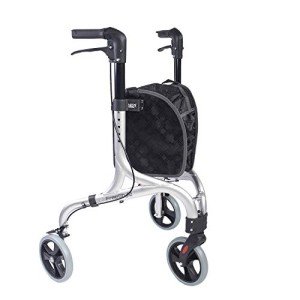
17
MayThe 10 Most Scariest Things About Medical Walker
Understanding Medical Walkers: A Comprehensive Guide
Medical walkers serve as important mobility aids for individuals recovering from surgical treatment, handling chronic illnesses, or handling age-related mobility issues. These devices not only enhance physical self-reliance however likewise improve safety, allowing users to browse their environments with greater ease. This article explores the types, benefits, features, and considerations associated Convenient Mobiclinic® Foldable Shopping Trolley with Seat medical walkers, along with some regularly asked concerns.
Tabulation
- Kinds Of Medical Walkers
- Benefits of Using a Medical Walker
- Key Features to Consider
- Frequently Asked Questions
- Conclusion
1. Kinds Of Medical Walkers
Medical walkers are available in numerous designs, dealing with various needs and choices. The main types consist of:
| Type of Walker | Description |
|---|---|
| Requirement Walker | A rectangle-shaped frame with four legs, offering stability and support. |
| Two-Wheeled Walker | Similar to a basic walker however geared up with wheels at the front for simpler movement. |
| Three-Wheeled Senior Walker | A lightweight walker with three wheels, permitting for more maneuverability, suitable for indoor use. |
| Top Rated Rollator Walker | A walker with four wheels, hand brakes, and a seat, suitable for longer ranges and resting needs. |
| Hemi Walker | Developed for individuals who can use just one hand, featuring a tripod-like design. |
2. Benefits of Using a Medical Walker
Utilizing a medical walker provides a number of benefits that add to the user's general well-being, consisting of:
- Increased Stability: Walkers offer a steady base of assistance, minimizing the danger of falls.
- Improved Mobility: They enable users to move more quickly, promoting independence.
- Pain Relief: By rearranging weight, walkers can ease discomfort in the joints, particularly in the hips and knees.
- Posture Support: These devices encourage appropriate posture, reducing stress on the back.
- Improved Confidence: Users frequently feel more safe and secure using walkers, leading to better self-esteem and increased activity levels.
3. Key Features to Consider
When picking a medical walker, it's essential to assess numerous functions to find the best fit. Here are some important aspects to think about:
- Weight Capacity: Ensure the walker can support the user's weight while preserving stability.
- Height Adjustment: Look for a walker with adjustable height settings to accommodate the user's height and offer comfortable grip.
- Product: Lightweight aluminum walkers are much easier to steer, while steel walkers offer stronger assistance but may be heavier.
- Wheel Quality: If choosing a wheeled walker, consider the wheel size and tread. Bigger wheels browse unequal surfaces more quickly.
- Seat Availability: If users will be walking for longer periods, a walker with an integrated seat can offer rest breaks when required.
- Brakes: Hand brakes are especially essential for safety in Bariatric Rollator walkers to manage speed and stop when required.
Kinds of Walkers with Features Comparison Table
| Walker Type | Weight Capacity | Height Adjustment | Wheels | Seat Available | Brakes |
|---|---|---|---|---|---|
| Standard Walker | Up to 300 pounds | Yes | No | No | No |
| Two-Wheeled Walker | As much as 300 pounds | Yes | Yes | No | No |
| Three-Wheeled Walker | Approximately 250 lbs | Yes | Yes | No | No |
| Compact Rollator Walker | Approximately 400 lbs | Yes | Yes | Yes | Yes |
| Hemi Walker | Approximately 250 pounds | Yes | No | No | No |
4. Regularly Asked Questions
Q1: Who need to use a medical walker?A: Medical walkers are helpful for individuals recovering from surgery, experiencing balance issues, or needing support due to age-related mobility difficulties. Q2: Can a medical walker be adjusted?A: Yes, the majority of
medical walkers are height-adjustable to accommodate various user heights, permitting a more comfy grip. Q3: How do I pick the best walker for my needs?A: Consider elements such as the
user's weight, height, type of mobility problems, and whether they require a seat or brakes. Evaluating the walker for comfort and stability before purchase is likewise advisable. Q4: Are there any safety tips connected with using a medical walker?A: Yes, users must ensure they do not lean too
heavily on the walker, use it on stable and level surface areas, and constantly ensure
the brakes are engaged when seated or stationary. Q5: Can walking with a medical walker aid with rehabilitation?A: Absolutely. Medical walkers are typically recommended as part of rehab programs as they motivate
physical activity, which aids in healing and mobility enhancement. 5.
Conclusion Medical walkers play a crucial role in boosting the quality of life for people facing mobility difficulties. With different types and functions readily available, selecting the right walker involves thinking about the user's specific requirements and circumstances. By comprehending their benefits and correct use, individuals can restore self-reliance, improve their mobility, and navigate their surroundings safely. Whether for short-term recovery or long-lasting assistance, the best medical walker can substantially improve a user's general well-being. Integrating a medical walker into one's day-to-day routine can be a transformative choice, making it easier to get involved in life's day-to-day activities while guaranteeing safety and confidence.


Reviews